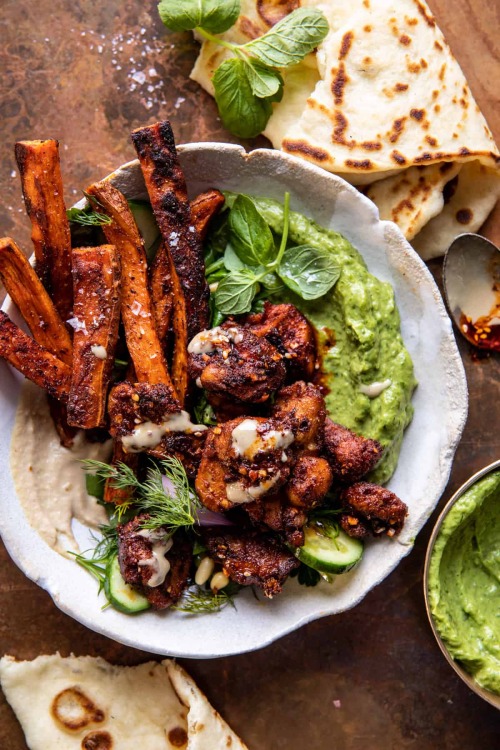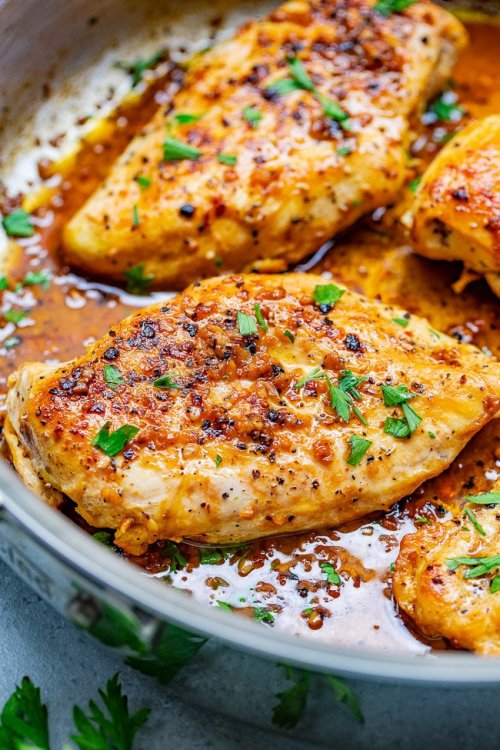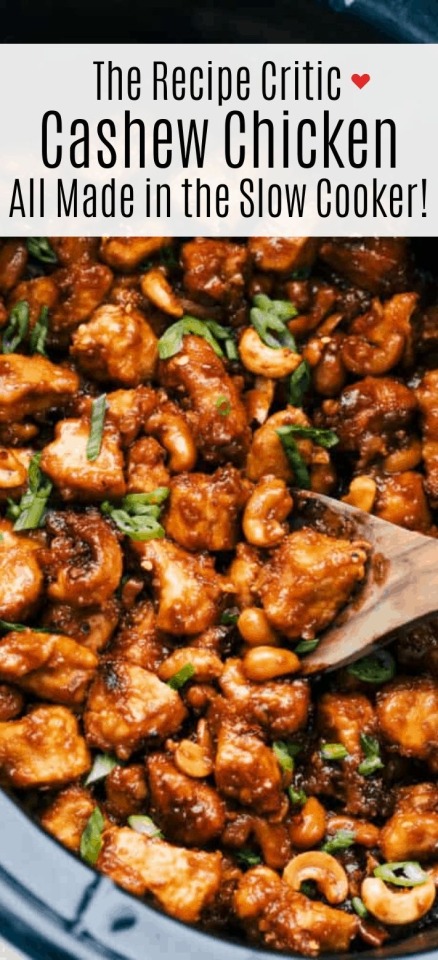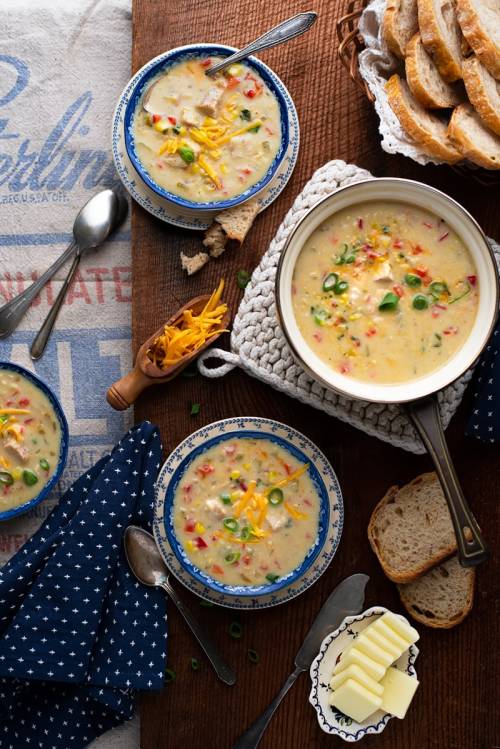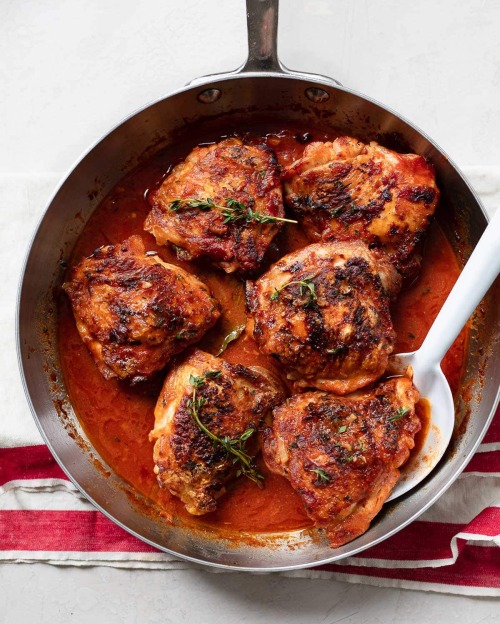#chicken recipes



Chicken breasts stuffed with mushrooms, spinach and chorizo in a black bean tomato sauce.
I sautéed some diced mushrooms in olive oil with diced (cooked) chorizo sausage, crushed garlic , finely diced onion, chilli and flat leaf parsley .
Once the mushrooms had softened, I added in a few handfuls of spinach and let them cook down, too.
I butterflied the chicken breasts, added the filling to the middle and rolled them up before placing in a baking dish and pouring over some tinned tomatoes which I’d mixed with some cooked black beans and the leftover stuffing mixture. Seasoned with salt and pepper. Drizzled with olive oil.
Baked for 40 minutes at 190 Celsius.
Enjoy!
Butterflied Cornish Hens with Sage Butter
Prep Time: 20 mins
Cook Time: 30 mins
Ingredients
- 4 (1 ¾-pound) Cornish game hens, butterflied
- 1 stick butter, softened
- 5 to 7 sage leaves, finely chopped
- 1 lemon, zested
- Salt and freshly ground black pepper
- Olive oil, for sauteing
- 4 strips bacon, chopped
Instructions
- Preheat oven to 425 degrees F.
- Place hens on a sheet tray fitted with a cooling rack in the refrigerator to dry skin out for 1 hour.
- Meanwhile, in a small pan over medium heat, melt butter with sage, zest, salt and pepper.
- Remove hens from refrigerator. Preheat 2 large saute pans over medium heat, lightly coat with oil. Season hens with salt and pepper and sear, skin side down, in the pans.
- Sear until skin caramelizes and turns golden brown and crispy, about 7 to 10 minutes.
- Flip birds over, and baste with sage butter. Sprinkle tops with chopped bacon and place in preheated oven to finish cooking, 25 to 30 minutes, basting occasionally.
- Let rest 10 minutes before serving.
Post link
If you are craving unhealthy food, and want to eat junk.. may I suggest you make these delicious low calories chicken fingers instead? This will totally satisfy the craving and will save you at least 400 calories over regular deep fried chicken fingers (not to mention fat…carbs… and a host of other unhealthy ingredients)!

Yields: 4 servings
Ingredients
12 ounces skinless, boneless chicken-breast halves
1 egg, slightly beaten
1 tablespoon honey
1 teaspoon prepared mustard
2 cups cornflakes, finely crushed
Dash of black pepper
Directions
1. Preheat oven to 450 degrees F. Slice chicken breast into 3 by ¾-inch strips.
2. Combine egg, honey, and mustard in small dish. In a separate dish, stir together corn flake crumbs and pepper.
2. Take chicken strips and cover in the egg mixture; roll in cornflake-crumb mixture to coat strips entirely. Arrange chicken strips on an ungreased baking sheet (you may wish to use parchment paper).
3. Bake about 12-14 minutes, or until outsides are golden and chicken is no longer pink.
Nutrition Info (per serving): 212 calories, 23g protein, 23g carbohydrate, 3g fat (1g saturated), 0g fiber
Today, I’ll be taking a look at another recipe from 13th century Syria - and the anonymously written Scents and Flavours Arabic cookbook - the creamy chicken Jurjaniyyah!
The name Jurjaniyyah is derived from an Iranian region - Gorgan - which suggests that this was an imported culinary style, rather than a local recipe! Either way, it’s a fairly simple and tasty dish!
In any case, lets now take a look at The World That Was! Follow along with my YouTube video, above!
Ingredients (Serves 4)
500g yoghurt
½ tablespoon flour dissolved in 1 tablespoon water
½ tablespoon honey
2 tablespoons mustard seeds
ground cumin
250g chicken thighs (or cut of your choice)
Method
1 - Bake the Chicken
To begin with, we need to cook our chicken. To do this, season a few thighs of chicken with salt, pepper, and freshly-ground cumin. I’m cooking the meat separately to the sauce, which is unusual for meat-based recipes in this time period - but this is seemingly how the dish was intended to be prepared!
In any case, bake or roast your chicken at 200C for about 30 minutes, or until it’s cooked through!
When it’s cooked, take it out of the oven and let it rest while you make your sauce.
2 - Make the Sauce
Next, we need to make our sauce. Start by placing 500g of Greek yoghurt into a saucepan. Into this, toss a slurry of 1 tbsp flour and 1tbsp water - this will help prevent the sauce curdling as it cooks. Place this over a high heat, and stir it. Contemporary Arabic cookbooks emphasise that you should stir this in a single direction, to reduce the risk of curdling. So stir it until you start to see bubbles forming at the edge.
At this point, turn the heat down to medium, and let it foam up and froth away for about 10 minutes.
3 - Assemble Dish
After 10 minutes, pour in a tablespoon of honey, and a couple of tablespoons of mustard seeds. The original recipe describes the dish as being very pungent, so you can adjust this by increasing or decreasing the amount of seeds you add here!
Place your chicken on a plate, and ladle on some of your sauce. Serve up warm and dig in!
The finished dish is super fragrant, and each mouthful of the sauce has a sharp bite of heat thanks to the mustard seeds. In a sense, it’s almost like horseradish! But overall, it’s more fragrant than it is hot - and acts very creamy!
Mustard seeds have been cultivated throughout the Near East for millennia, and had a variety of uses besides the culinary field. However the popularity of this seed as an ingredient seems to have increased following the occupation of the region by the Roman Empire - as well as subsequent empires and caliphates.
How and why a Persian recipe was recorded in a Syrian cookbook that charts local, regional tastes could suggest that this dish was popular enough at the time of writing in the region that it felt right at home alongside other dishes (such as my chicken with blackberry sauce)


